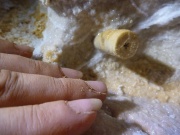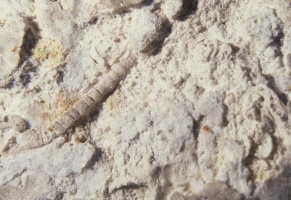Fossils (Inventory)/Crinoid
From LagWiki
(Difference between revisions)
(Move the gallery) |
|||
| (4 intermediate revisions not shown) | |||
| Line 1: | Line 1: | ||
| - | + | {{Inventory image|File:Crinoid.JPG|An exceptional example of a crinoid. Most are much more difficult to recognize.}} | |
The '''Crinoid''' field should be used to record stations where crinoid [[Fossils (Inventory)|fossils]] are found. | The '''Crinoid''' field should be used to record stations where crinoid [[Fossils (Inventory)|fossils]] are found. | ||
| Line 5: | Line 5: | ||
A complete crinoid looks like a lily with what appear to be roots, a stem and a flower; but, they are not plants but animals. Any portion may be exposed as a fossil; but, usually, the fossils are a cross section of the long stem and it appears like a stack of buttons. | A complete crinoid looks like a lily with what appear to be roots, a stem and a flower; but, they are not plants but animals. Any portion may be exposed as a fossil; but, usually, the fossils are a cross section of the long stem and it appears like a stack of buttons. | ||
| + | |||
| + | Crinoids may be difficult to recognize and obscured by other formations. Look for them anywhere bedrock is exposed including breakdown. | ||
==References== | ==References== | ||
*Palmer, Arthur N. (2007) ''Cave Geology'' CAVE BOOKS, Dayton, OH p 72 ISBN-13: [[Special:Booksources/978-0-939748-66-2|978-0-939748-66-2]], ISBN-10: [[Special:Booksources/0-939748-66-5|0-939748-66-5]] | *Palmer, Arthur N. (2007) ''Cave Geology'' CAVE BOOKS, Dayton, OH p 72 ISBN-13: [[Special:Booksources/978-0-939748-66-2|978-0-939748-66-2]], ISBN-10: [[Special:Booksources/0-939748-66-5|0-939748-66-5]] | ||
| + | |||
| + | ==Crinoid, Fossils== | ||
| + | <gallery perrow=1 widths=300px heights=200px> | ||
| + | File:crinoid stem.jpg|Crinoid stem | ||
| + | </gallery> | ||
{{Cave inventory}} | {{Cave inventory}} | ||
Current revision as of 01:40, 10 August 2013
The Crinoid field should be used to record stations where crinoid fossils are found.
Crinoids are a marine animal which may be preserved in the bedrock as fossils. These fossils may then be exposed.
A complete crinoid looks like a lily with what appear to be roots, a stem and a flower; but, they are not plants but animals. Any portion may be exposed as a fossil; but, usually, the fossils are a cross section of the long stem and it appears like a stack of buttons.
Crinoids may be difficult to recognize and obscured by other formations. Look for them anywhere bedrock is exposed including breakdown.
References
- Palmer, Arthur N. (2007) Cave Geology CAVE BOOKS, Dayton, OH p 72 ISBN-13: 978-0-939748-66-2, ISBN-10: 0-939748-66-5
Crinoid, Fossils


